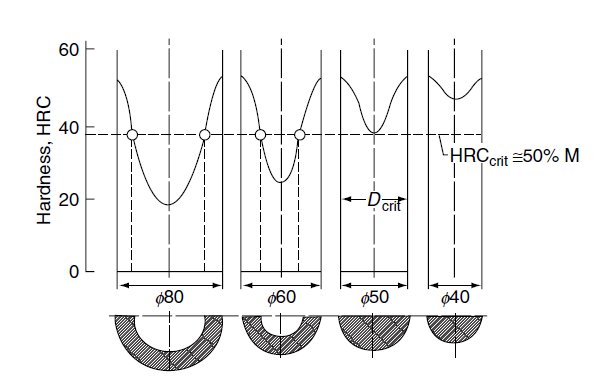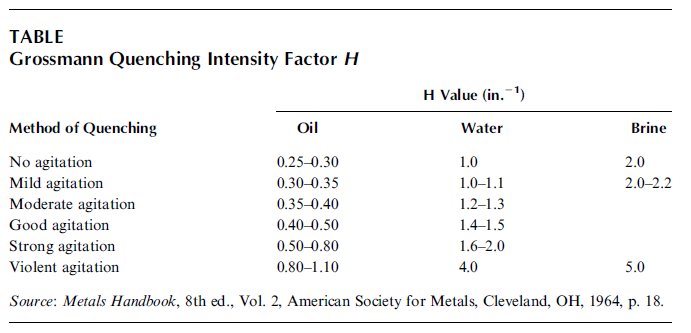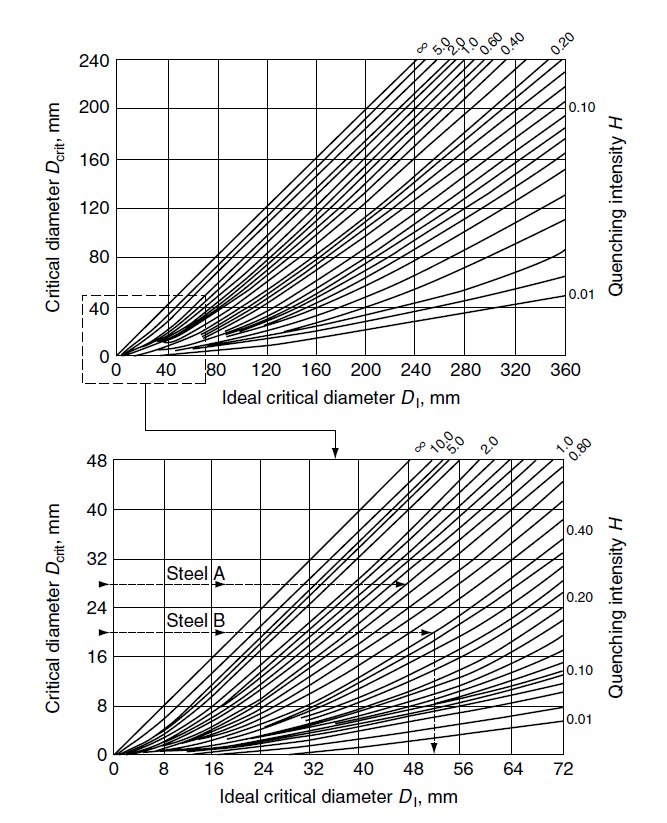
Alphabetical Index
Chemical Composition
Keyword Search
AFNOR Steels
AISI/SAE Steels
BS Steels
DIN Steels
EN Steels
JIS Steels
JUS Steels
GB Steels
GOST Steels
Mat.No (Wr.Nr.) Steels
Alloy Steels
Boron Steels
Carbon Steels
Case Hardening Steels
New Diagrams
Nitriding Steels
Spring Steels
Steel Companies
Structural Steels
Tool Steels
Help
Home
Grossmannís Hardenability Test
Grossmannís method of testing hardenability uses a number of cylindrical steel bars of
different diameters hardened in a given quenching medium. After sectioning each bar at
midlength and examining it metallographically, the bar that has 50% martensite at its center is
selected, and the diameter of this bar is designated as the critical diameter (Dcrit). The
hardness value corresponding to 50% martensite will be determined exactly at the center of
the bar of Dcrit. Other bars with diameters smaller than Dcrit have more than 50% martensite
in the center of the cross section and correspondingly higher hardness, while bars having
diameters larger than Dcrit attain 50% martensite only up to a certain depth as shown in
Figure 1. The critical diameter Dcrit is valid for the quenching medium in which the bars
have been quenched. If one varies the quenching medium, a different critical diameter will be
obtained for the same steel.
Determination of the critical diameter Dcrit according to Grossmann

Figure 1: Determination of the critical diameter Dcrit according to Grossmann. (From G. Spur (Ed.),
Handbuch der Fertigungstechnik, Band 4=2, Wa®rmebehandeln, Carl Hanser, Munich, 1987, p. 1012.)
To identify a quenching medium and its condition, Grossmann introduced the quenching
intensity (severity) factor H. The H values for oil, water, and brine under various rates of
agitation are given in Table 1. From this table, the large influence of the agitation rate on
the quenching intensity is evident.
Grossmann quenching intensity factor H

Table 1: Grossmann quenching intensity factor H.
To determine the hardenability of a steel independently of the quenching medium,
Grossmann introduced the ideal critical diameter DI, which is defined as the diameter of a
given steel that would produce 50% martensite at the center when quenched in a bath of
quenching intensity H=∞. Here, H=∞ indicates a hypothetical quenching intensity that
reduces the surface temperature of the heated steel to the bath temperature in zero time.
Grossmann and his coworkers also constructed a chart, shown in Figure 2, that allows the
conversion of any value of critical diameter Dcrit for a given H value to the corresponding
value for the ideal critical diameter (DI) of the steel in question.
Grossmann chart

Figure 2: The chart for converting the values of the critical diameter Dcrit into the ideal critical
diameter DI, or vice versa, for any given quenching intensity H, according to Grossmann and coworkers.
(From K.E. Thelning, Steel and Its Heat Treatment, 2nd ed., Butterworths, London, 1984, p. 145.).
For example, after quenching in still water (H-1.0), a round bar constructed of steel A
has a critical diameter (Dcrit) of 28 mm according to Figure 2. This corresponds to an ideal
critical diameter (DI) of 48 mm. Another round bar, constructed of steel B, after quenching in
oil (H=0.4), has a critical diameter (Dcrit) of 20 mm. Converting this value, using Figure 2,
provides an ideal critical diameter (DI) of 52 mm. Thus, steel B has a higher hardenability
than steel A. This indicates that DI is a measure of steel hardenability that is independent of
the quenching medium.
For more information please see the link Steel Heat Treatment: Metallurgy and Technologies
Reference: George E. Totten, Steel Heat Treatment: Metallurgy and Technologies, CRC Press, 2007, pp. 217-230.